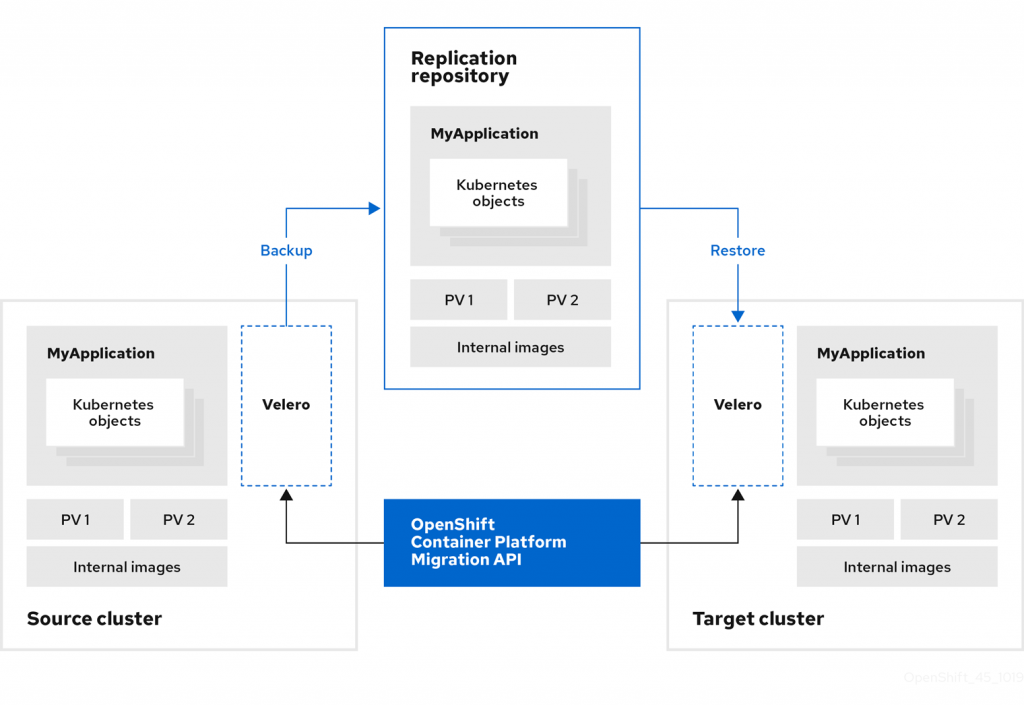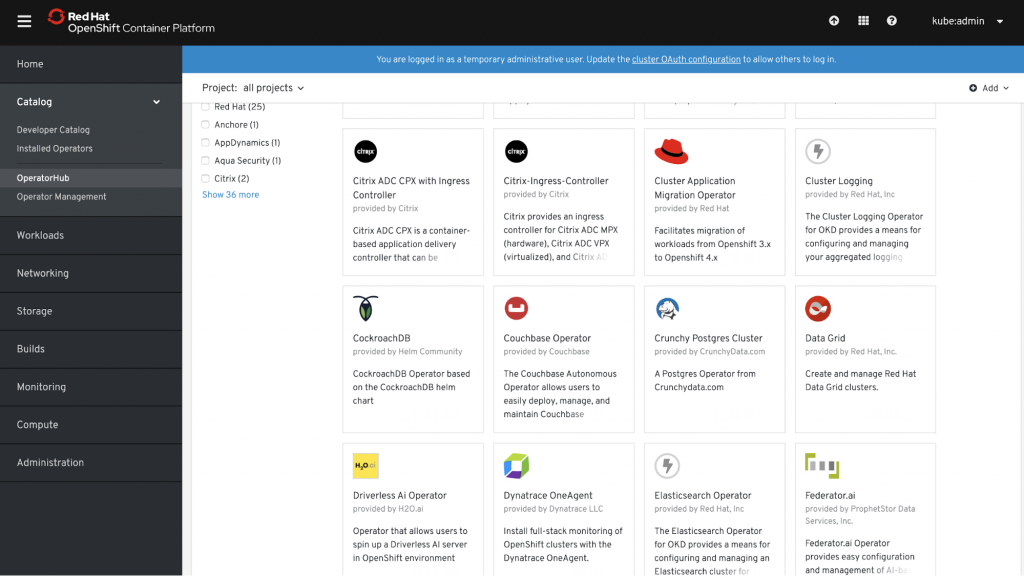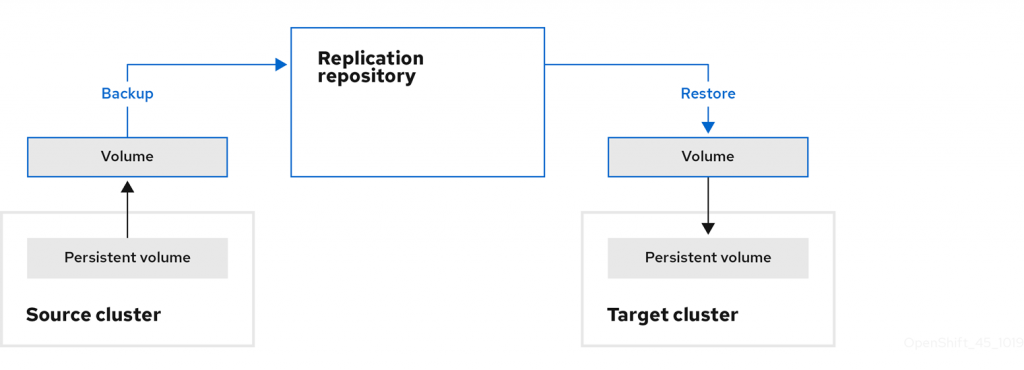If you’re looking for a path to upgrade your Red Hat OpenShift 3.7+ cluster to OpenShift 4.2, you’re in luck. The Migration Toolkit for Containers was built to migrate stateful and stateless applications from a source cluster to a destination cluster.
The initial intent of this tool is to address the OCP 3.7+ to OCP 4.2+ upgrade scenarios. That said, as requested by many Openshift users, it will also be possible to use this tool to migrate applications between OCP4 clusters.
This tool is based on two popular open source projects: Velero and Restic.
https://github.com/vmware-tanzu/velero
High-Level Architecture

Velero is installed on both your source and destination cluster, and object storage is used to store your backup information before getting restored on your target cluster. The OpenShift Container Platform Migration API orchestrates your migration from a central location. This API includes an easy to use user-interface and is usually installed on your target cluster by an operator.
Migrating Persistent Volumes
The migration of your PVs was a major focus for us in building this migration tool. Migration Toolkit for Containers 1.0 offers two different mechanisms to migrate your data: MOVE or COPY.
1. Move the Persistent Volume
Moving PVs requires shared storage between your source and destination cluster (ex: NFS). This is the fastest option and offers minimal downtime as the data is not copied, but only re-attached to the destination cluster.
2. Copy the Persistent Volume
This is a two-step approach which can support all storage backends (default option). Your data is first copied on your replication repository and then restored on your target cluster. Your migration can be first "stage" to copy most of the data without any impact to your source cluster. Then, your can "migrate" which will only copy files that have been changed since your last staging, reducing the downtime significantly before the final cut-over.
The Migration Web UI
Your migrations can be fully executed from a simple web UI. The configuration steps are simple:
- Add both your source and destination clusters by providing your endpoint and credentials.
- Add an object storage repository by also providing the end point and your credentials.
- Finally, create a migration plan listing all of the projects (namespaces) that you would like to migrate.
Things to Know
1. Cluster scoped resources
Cluster scoped resources are currently not migrated by this tool as they are not part of your namespace. Only resources inside your namespace are migrated. Our CPMA tool can help you find those resources and configure them to your new targeted cluster before executing your migration.
2. Moving traffic to your new cluster
Once your migration is completed, your traffic must be redirected to your new cluster. The most common way to do this would be to either update your DNS entry or change your load balancer configuration. Using a load balancer in a multi-cluster configuration is a great way to reduce your downtime. If you are currently only using one cluster, this might be a good opportunity to look at the advantages of running a fully redundant cluster architecture.
3. Cluster Admin Requirement
In Migration Toolkit for Containers 1.0, you will need cluster admin privileges to perform a migration. This is something we hope to improve in the near future to allow app owners to migrate their own applications without such privilege.
To get started, check out the documentation on the Cluster Application Migration Operator from the embedded OperatorHub in Red Hat OpenShift.
À propos de l'auteur
Red Hatter since 2018, technology historian and founder of The Museum of Art and Digital Entertainment. Two decades of journalism mixed with technology expertise, storytelling and oodles of computing experience from inception to ewaste recycling. I have taught or had my work used in classes at USF, SFSU, AAU, UC Law Hastings and Harvard Law.
I have worked with the EFF, Stanford, MIT, and Archive.org to brief the US Copyright Office and change US copyright law. We won multiple exemptions to the DMCA, accepted and implemented by the Librarian of Congress. My writings have appeared in Wired, Bloomberg, Make Magazine, SD Times, The Austin American Statesman, The Atlanta Journal Constitution and many other outlets.
I have been written about by the Wall Street Journal, The Washington Post, Wired and The Atlantic. I have been called "The Gertrude Stein of Video Games," an honor I accept, as I live less than a mile from her childhood home in Oakland, CA. I was project lead on the first successful institutional preservation and rebooting of the first massively multiplayer game, Habitat, for the C64, from 1986: https://neohabitat.org . I've consulted and collaborated with the NY MOMA, the Oakland Museum of California, Cisco, Semtech, Twilio, Game Developers Conference, NGNX, the Anti-Defamation League, the Library of Congress and the Oakland Public Library System on projects, contracts, and exhibitions.
Parcourir par canal
Automatisation
Les dernières nouveautés en matière d'automatisation informatique pour les technologies, les équipes et les environnements
Intelligence artificielle
Actualité sur les plateformes qui permettent aux clients d'exécuter des charges de travail d'IA sur tout type d'environnement
Cloud hybride ouvert
Découvrez comment créer un avenir flexible grâce au cloud hybride
Sécurité
Les dernières actualités sur la façon dont nous réduisons les risques dans tous les environnements et technologies
Edge computing
Actualité sur les plateformes qui simplifient les opérations en périphérie
Infrastructure
Les dernières nouveautés sur la plateforme Linux d'entreprise leader au monde
Applications
À l’intérieur de nos solutions aux défis d’application les plus difficiles
Programmes originaux
Histoires passionnantes de créateurs et de leaders de technologies d'entreprise
Produits
- Red Hat Enterprise Linux
- Red Hat OpenShift
- Red Hat Ansible Automation Platform
- Services cloud
- Voir tous les produits
Outils
- Formation et certification
- Mon compte
- Assistance client
- Ressources développeurs
- Rechercher un partenaire
- Red Hat Ecosystem Catalog
- Calculateur de valeur Red Hat
- Documentation
Essayer, acheter et vendre
Communication
- Contacter le service commercial
- Contactez notre service clientèle
- Contacter le service de formation
- Réseaux sociaux
À propos de Red Hat
Premier éditeur mondial de solutions Open Source pour les entreprises, nous fournissons des technologies Linux, cloud, de conteneurs et Kubernetes. Nous proposons des solutions stables qui aident les entreprises à jongler avec les divers environnements et plateformes, du cœur du datacenter à la périphérie du réseau.
Sélectionner une langue
Red Hat legal and privacy links
- À propos de Red Hat
- Carrières
- Événements
- Bureaux
- Contacter Red Hat
- Lire le blog Red Hat
- Diversité, équité et inclusion
- Cool Stuff Store
- Red Hat Summit







